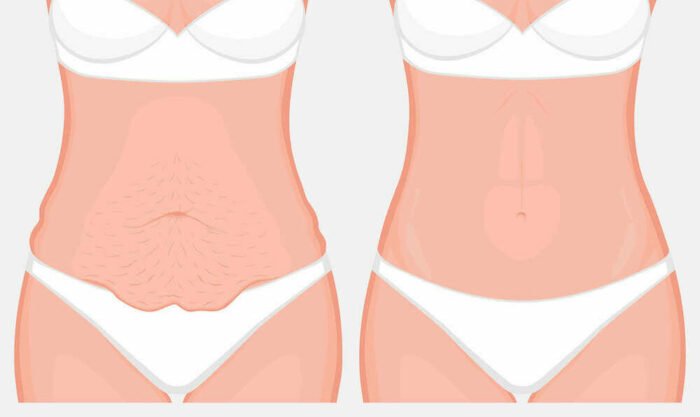Abdominoplasty
Abdominoplasty (also known as a Tummy Tuck) is performed to restore the body contour, remove excess abdominal loose skin and fat that has occurred after massive weight loss to restore and enhance the form of your abdominal wall.
It involves the removal of excess skin and fat, whilst tightening the underlying abdominal musculature and can be performed for cosmetic reasons or as a reconstructive procedure to correct abdominal muscle separation (rectus divarication) especially after pregnancy, or massive weight loss. Abdominoplasty is designed to remove excess skin and fat from the abdomen, while also repairing separated abdominal muscles. This procedure effectively reduces the skin folds and bulge caused by loose skin, fat, and weakened muscles, resulting in a flatter, firmer, and more shaped abdomen. It can also help define the waistline.
Who is this for?
At Sunnybank Surgical, we offer abdominoplasty to individuals who have experienced massive weight loss often in the post weight-loss bariatric surgery setting. In general, the BMI has to be <30 kg/m2.
Large cohort studies data suggest that the best candidates for tummy tuck surgery are those who have achieved sufficient weight-loss and are now within a normal weight range, demonstrate weight stability, eat a healthy diet and are active and engage in regular exercise. Absence from other significant medical conditions such as diabetes and immunosuppressive disorders are important in ensuring an optimal outcome.
Abdominoplasty is not suitable for obese individuals who wish to have their abdominal fat removed surgically.
Types of Abdominoplasty Procedures
Standard Abdominoplasty: This procedure removes excess skin and fat from the lower abdomen. It also tightens the underlying muscle. This technique involves raising an abdominal flap which is pulled down and excess skin and fat is excised. The underlying abdominal muscles are tightened to improve the contour of the abdomen. The umbilicus (belly-button) is kept and repositioned to come out on the new tightened abdominal flap. The flap is pulled down tight and repaired so the scar sits within the underwear line. This procedure can be performed in one position lying down (supine).
Abdominoplasty with liposuction: Also known as lipoabdominoplasty, this technique combines an abdominoplasty with liposuction to reduce the volume of the upper abdominal flap and flanks which are unable to be resected to improve the contour of the abdomen. Liposuction is also used to perform abdominal etching so that the abdominal skin is more defined and aesthetically pleasing.
Monsplasty: This is a procedure commonly performed in combination with an abdominoplasty. It addresses the excess skin and fat of the mons pubis which also commonly descends and forms a fold. The excess skin and fat of the mons is removed to improve the contour of the mons as it meets the abdomen. The mons pubis is also suspended to deep underlying tissue to prevent descent.
Mini abdominoplasty: This is the least involved type of abdominoplasty, specifically designed for patients who require a small amount of excess skin or abdominal fold removed in the lower abdomen, and where there is no excess in the upper abdomen. This procedure usually does not require the relocation of the umbilicus (belly button).
360 Abdominoplasty: Also known as a body lift, this technique addresses excess skin and fat circumferentially around the torso. It involves a position change during the operation from lying on the stomach (prone) to lying on the back (supine). Excess skin and fat is removed from the lower back, the flanks, and lower abdomen. The underlying abdominal muscles are tightened. The abdominal skin is pulled down and repaired so the scar sits low in the underwear line. This technique has the benefit of lifting the buttocks and lateral thighs which a standard abdominoplasty cannot address. This is a common procedure for massive weight loss.
Reverse Abdominoplasty: Focused on the upper abdomen, this procedure removes excess skin and lifts the tissues upward, addressing the appearance of the upper torso. This technique uses an incision which sits under the breast or at the chest/abdomen junction. This can be combined with many types of breast surgery as they share the same incision.
Corset Abdominoplasty: This is the most involved type of abdominoplasty, specifically designed to maximise the amount of resected skin for massive weight loss. This technique involves an upper and lower circumferential abdominoplasty, as well as a vertical midline tightening to remove excess skin from the midsection and sides. Tightening of the underlying abdominal muscles and relocation of the umbilicus (belly button) is also performed. This is a useful procedure for massive weight loss.
Why undergo Abdominoplasty?
Excess skin and subcutaneous fat due to rapid weight loss may alter body contour and result in body image issues that affect self-esteem and decrease quality of life by creating a hinderance to physical activity and possess a challenge to hygiene.
There is now also data to suggest that removing excess skin might reduce secondary weight regain after bariatric weight-loss surgery. This may be attributed to increased body satisfaction and hence leads to improved physical function but may also be caused by a biological response to reduction of adipose tissue.
Risk of Abdominoplasty
Due to the large amount of tissue removed and extended surgical dissection of tissue planes, bruising, swelling, oozing or small amount of bleeding from wounds can occur. Scarring develops from long incisions. Deep venous thrombosis and other risks of general anaesthesia needs to be considered.
Specific risks include bleeding, seroma – the accumulation of fluid under the abdominal skin, asymmetry and irregularities, fat necrosis along the wounds, delayed wound healing problems, scarring and the need for further revisional surgery.

